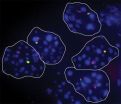(Press-News.org) AMHERST, Mass. – Like a kindergarten or a busy airport where cold viruses and other germs circulate freely, flowers are common gathering places where pollinators such as bees and butterflies can pick up fungal, bacterial or viral infections that might be as benign as the sniffles or as debilitating as influenza.
But "almost nothing is known regarding how pathogens of pollinators are transmitted at flowers," postdoctoral researcher Scott McArt and Professor Lynn Adler at the University of Massachusetts Amherst write. "As major hubs of plant-animal interactions throughout the world, flowers are ideal venues for the transmission of microbes among plants and animals."
In a recent review in Ecology Letters with colleagues at Yale and the University of Texas at Austin, McArt and Adler survey the literature and identify promising areas for future research on how floral traits influence pathogen transmission.
As the authors point out, "Given recent concerns about pollinator declines caused in part by pathogens, the role of floral traits in mediating pathogen transmission is a key area for further research." They say their synthesis could help efforts to control economically devastating pollinator-vectored plant pathogens such as fire blight, which affects rose family fruits such as apples and pears, and mummyberry disease, which attacks blueberries.
McArt adds, "Our intent with this paper is to stimulate interest in the fascinating yet poorly understood microbial world of flowers. We found several generalities in how plant pathogens are transmitted at flowers, yet the major take-home from our paper may be in pointing out that this is an important gap in our knowledge."
The authors identified 187 studies pertaining to plant pathogens published between 1947 and 2013 in which floral visitors were implicated in transmission and where transmission must have occurred at flowers or pathogen-induced pseudoflowers. These are flower-like structures made by a pathogen that can look and smell like a real flower, for example. Regarding animal pathogens, they identified 618 studies published before September 2013 using the same criteria.
"In total, we found eight major groups of animal pathogens that are potentially transmitted at flowers, including a trypanosomatid, fungi, bacteria and RNA viruses," they note. Their paper, "Arranging the bouquet of disease: Floral traits and the transmission of plant and animal pathogens," was featured in the publisher's "News Round-Up" of "most newsworthy research."
Traditionally, research on flower evolution has focused largely on selection by pollinators, but as McArt and colleagues point out, pollinators that also transmit pathogens may reduce the benefits to the plant of attracting them, depending on the costs and benefits of pollination. The researchers say more work is needed before scientists can know whether a flower's chemical or physical traits determine the likelihood that pathogens are transmitted, for example, and whether infection by pathogens is an inevitable consequence of pollinator visitation.
"Plant pathologists have made great strides in identifying floral traits that mediate host plant resistance to floral pathogens in individual systems; synthesizing this literature can provide generality in identifying traits that mediate plant-pathogen dynamics. From the pollinator's perspective, there has been surprisingly little work elucidating the role of flowers and floral traits for pathogen transmission. Given recent concerns about pollinator declines caused in part by pathogens, understanding the role of floral traits in disease transmission is a key missing element," say McArt and colleagues.
INFORMATION:
As hubs for bees and pollinators, flowers may be crucial in disease transmission
2014-02-24
ELSE PRESS RELEASES FROM THIS DATE:
Mental health conditions in most suicide victims left undiagnosed at doctor visits
2014-02-24
VIDEO:
The mental health conditions of most people who commit suicide remain undiagnosed, even though many visit a primary care provider or medical specialist in the year before they die, according...
Click here for more information.
DETROIT – The mental health conditions of most people who commit suicide remain undiagnosed, even though many visit a primary care provider or medical specialist in the year before they die, according to a national study led by Henry Ford Health ...
Cancer patients turning to mass media and non-experts for info
2014-02-24
PHILADELPHIA (February 24, 2014) – The increasing use of expensive medical imaging procedures in the U.S. like positron emission tomography (PET) scans is being driven, in part, by patient decisions made after obtaining information from lay media and non-experts, and not from health care providers.
That is the result from a three-year-long analysis of survey data, and is published in the article , "Associations between Cancer-Related Information Seeking and Receiving PET Imaging for Routine Cancer Surveillance – An Analysis of Longitudinal Survey Data," appearing in ...
JCI early table of contents for Feb. 24, 2014
2014-02-24
PPAR-γ agonist reverses cigarette smoke induced emphysema in mice
Pulmonary emphysema results in irreversible lung damage and is most often the result of long term cigarette smoke exposure. Immune cells, such as macrophages and myeloid dendritic cells (mDCs) accumulate in the lungs of smokers with emphysema and release cytokines associated with autoimmune and inflammatory responses. In this issue of the Journal of Clinical Investigation Farrah Kheradmand and colleagues at Baylor University found that peroxisome proliferator activated receptor-γ (PPARγ) ...
Mdm2 suppresses tumors by pulling the plug on glycolysis
2014-02-24
Cancer cells have long been known to have higher rates of the energy-generating metabolic pathway known as glycolysis. This enhanced glycolysis, a phenomenon known as the Warburg effect, is thought to allow cancer cells to survive the oxygen-deficient conditions they experience in the center of solid tumors. A study in The Journal of Cell Biology reveals how damaged cells normally switch off glycolysis as they shut down and shows that defects in this process may contribute to the early stages of tumor development.
Various stresses can cause cells to cease proliferating ...
Two-pronged approach successfully targets DNA synthesis in leukemic cells
2014-02-24
A novel two-pronged strategy targeting DNA synthesis can treat leukemia in mice, according to a study in The Journal of Experimental Medicine.
Current treatments for acute lymphoblastic leukemia (ALL), an aggressive form of blood cancer, include conventional chemotherapy drugs that inhibit DNA synthesis. These drugs are effective but have serious side effects on normal dividing tissues.
In order to replicate, cells must make copies of their DNA, which is made up of building blocks called deoxyribonucleotide triphosphates (dNTPs). Cells can either make dNTPs from scratch ...
Blocking autophagy with malaria drug may help overcome resistance to melanoma BRAF drugs
2014-02-24
PHILADELPHIA— Half of melanoma patients with the BRAF mutation have a positive response to treatment with BRAF inhibitors, but nearly all of those patients develop resistance to the drugs and experience disease progression.
Now, a new preclinical study published online ahead of print in the Journal of Clinical Investigation from Penn Medicine researchers found that in many cases the root of the resistance may lie in a never-before-seen autophagy mechanism induced by the BRAF inhibitors vermurafenib and dabrafenib. Autophagy is a process by which cancer cells recycle ...
Like mom or dad? Some cells randomly express one parent's version of a gene over the other
2014-02-24
Cold Spring Harbor, NY – We are a product of our parents. Maybe you have your mother's large, dark eyes, and you inherited your father's infectious smile. Both parents contribute one copy, or allele, of each gene to their offspring, so that we have two copies of every gene for a given trait – one from mom, the other from dad. In general, both copies of a gene are switched on or off as an embryo develops into an adult. The "switching on" of a gene begins the process of gene expression that ultimately results in the production of a protein.
Occasionally, a cell will arbitrarily ...
Caring for patients with multiple chronic conditions -- New research and future challenges
2014-02-24
Philadelphia, Pa. (February 21, 2014) – The millions of Americans living with more than one chronic disease are at high risk of poor health outcomes, and account for a disproportionate share of health care costs. A special March supplement to Medical Care presents updates from the Agency for Healthcare Research and Quality's (AHRQ) Multiple Chronic Conditions (MCC) Research Network, formed to address knowledge gaps and research challenges in meeting the complex health care needs of this growing population. The journal is published by Lippincott Williams & Wilkins, a part ...
Nearly half of uninsured children live in immigrant families, reports study in Medical Care
2014-02-24
Philadelphia, Pa. (February 21, 2014) – Children from immigrant families now account for 42 percent of uninsured children in the United States, reports a study in the March issue of Medical Care. The journal is published by Lippincott Williams & Wilkins, a part of Wolters Kluwer Health.
More than two-thirds of uninsured children with immigrant parents are US citizens, according to an analysis of nationwide survey data by Eric E. Seiber, PhD, of The Ohio State University College of Public Health, Columbus. He writes, "Initiatives to expand coverage or increase Medicaid ...
Preventing suicide should start in a general medical setting
2014-02-24
The mental health conditions of most people who commit suicide remain undiagnosed, even though most visit a primary care provider or medical specialist in the year before they die. To help prevent suicides, health care providers should therefore become more attuned to their patients' mental health state and possible suicide ideation. These are the findings of Brian Ahmedani from the Henry Ford Health System in Detroit, Michigan, in a new study¹ documenting the type and timing of health services sought by Americans who commit suicide. The study is the largest geographically ...





